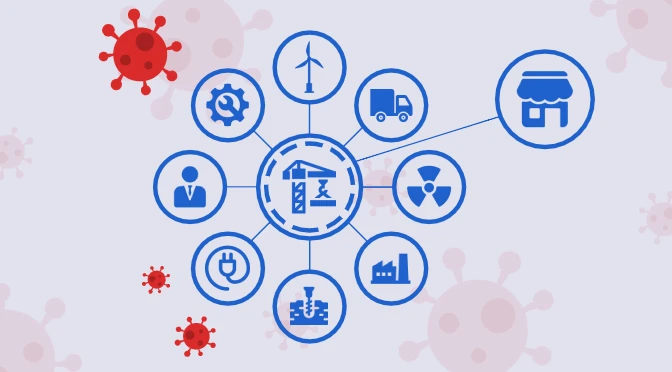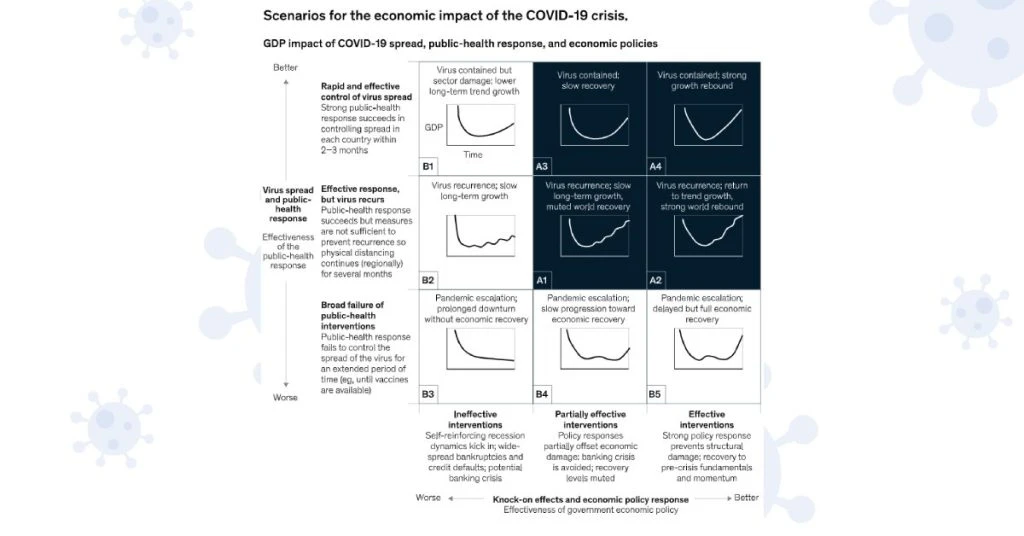COVID-19 Impact: The Rise of Digital and eCommerce Businesses

Within the first few months of 2020, the coronavirus (COVID-19) pandemic has swept over the world like a juggernaut affecting all nations, impacting millions of people, and encompassing every sphere of human life. The COVID-19 virus is the first of its kind to affect humankind on such an enormous scale, covering more than 184 countries.
The pandemic has not only resulted in a nationwide panic about the situation. It has also led governments around the world to take measures for minimizing human interactions. What started with the government advising simple steps of observing home quarantine have ultimately resulted in a call for a nationwide lockdown across countries.
The lockdown has no doubt had a positive effect. It helped to slow down the widespread increase in the number of COVID-19 cases around the world. Still, its adverse effects have slowly started making themselves prominent.
The repercussions it has had on the different economies around the world have been stark and has started showing cracks in even the strongest of industries. The stock market has been exhibiting a steady downward trend due to investors being skeptical about the market scenario.
According to a report by McKinsey, which highlights the possible trends in the rise and fall of GDP during and after COVID-19, all the nine possible scenarios predict an initial decline in world GDP. After this decline, it is anticipated that the economy would exhibit recovery in the long term in eight out of the nine cases.

In these eight out of nine cases, 50% of the scenarios are expected to have rapid growth. In contrast, in the remaining 50%, the rate of recovery is expected to be sluggish.
Most economic experts predict that there would be a rapid recovery in GDP after the pandemic. But in the absence of an effective vaccine to counter the virus, it would not be easy to rule out the other possibilities. This situation can happen if there is a lack of effective policies to prevent unemployment, bankruptcies, and, ultimately, a financial crisis.
On the 19th of March, 2020, PM Narendra Modi addressed the people of India asking them to observe a self-imposed curfew on the 22nd of March, which was extended to a nationwide lockdown by the 24th of March. These measures were taken to curb further the spread of the virus among the Indian population.
The Indian government had earlier imposed a ban on the arrival and departure of all international flights to and from India. Now, even state governments have entirely sealed off their boundaries apart from the transportation of essential goods across the state borders.
These measures are bound to affect the entire economy as it directly affects the supply chains wherein only the essential goods and commodities get shipped. This situation impacts the industry for any product that is deemed as non-essential. Which primarily refers to the market for anything starting from clothing, jewelry, bags, luxury items, and on-demand services such as transportation service providers such as Uber, Rapido, and many more.
Effect of the Lockdown Period on Different Industries
Manufacturing Industry
The manufacturing industry for non-essential goods has experienced the worst hit, with some companies heading towards bankruptcy. Some of them are shutting down their operations for the benefit of their workers while some are reducing the taskforce and making the workers work in shifts to reduce the number of service hours.

Some of these measures are for the benefit of the employees. In contrast, others are essential measures to cut down costs since the companies are facing decreased sales and, thereby, a lower profit margin.
On the 19th of March, 2020, a press release by the Federation of Indian Exports Organizations (FIEO) stated that the Micro, Small and Medium Enterprises (MSMEs) are most likely to face the worst blow.
At the time of the release, the export sector had already started to feel the impact of the COVID outbreak since it had started receiving requests from many buyers to delay the shipments. These requests could ultimately converge into a large number of orders being canceled in bulk. This move would result in a huge blow to the sector, leading to a rapid increase in the level of unemployment.

Services Industries
The services sector can yet sustain themselves through digitization. Different companies that are involved in the provision of IT services, consultancy services, network operators can still carry on their operations through digital networks. Most of the service companies have optimized their operations in a way that allows them to work from home under these circumstances.
Among financial services, the online insurance industry has experienced a spike of about 20-30% within the period from the 6th of March to the 31st of March, 2020 as compared to that in February. Although the offline sales of insurance have fallen, the spike in online sales has been largely due to the growing panic in the minds of the consumers about the pandemic.
This situation has led to the emergence of video communication platforms, such as Zoom, to emerge. These platforms have helped companies streamline the process of communication internally as well as externally in an organization.
These platforms have also helped the employees to optimize the process of working from home and ensure that it is no longer a hindrance. It can now achieve the same results that can be obtained by an employee working in the office for the same duration.
With so many people working from home, there exists a huge scope for the telecom industry and its main players. The ‘work from home’ policy has increased the demand for home broadband as well as mobile network services – this means that people will opt for data packages which provide a higher amount of data so that they can work seamlessly during this time.
Thus, the network of independent broadband service providers, as well as network service providers, stand to gain from such a move.
Among the service companies, the travel and tourism industry would probably take the biggest hit. Surprisingly the biggest loser in this industry is also a part of the e-commerce economy. The largest e-commerce company in terms of revenue is IRCTC, which deals with the booking of nearly 300 million tickets every year through its online portal.
But with restrictions on travel, the company, like the whole sector, is bound to face huge repercussions. This sector includes the whole value chain, which consists of taxi operators, drivers, travel agents, tourism agents, and hotels. The online travel aggregators (OTAs) such as MakeMyTrip and Yatra have seen their stocks fall by 50% in one month (March 2020).
The main cause of this is because the government has stopped the issue of visas to foreign travelers, and domestic travel has also been restricted. Apart from this, the major months of the lockdown – that is, from April to July – also coincides with the peak season for holidays in India.
Apart from this, some specific service platforms have gained from such a predicament. At the forefront of the services that have gained are on-demand services such as food delivery. Zomato and Swiggy came up with a reactive strategy during the very early days of the ban, through which they offer contactless delivery.
They also provided assurance that the food was being cooked in kitchen facilities that were sanitized as per the guidelines of the WHO. This facility also included conducting daily temperature checks of the cooks and the delivery executives. Apart from this, they assure that the customer can check the photos of the sanitized kitchen facilities as proof of their promises made.
This has made both the food delivery as well as the restaurant businesses upgrade their quality of service, and they are still operational and generating good business.
Virtual On-Demand Services
The landscape for virtual on-demand services has experienced a massive boost as on-demand streaming sites gain a major chunk of the revenue. The biggest players in this field would include Video-on-demand platforms such as Netflix, Amazon Prime, Hotstar, Hulu, and so on.

According to a report published by the global marketing firm Nielsen, online media streaming is supposed to increase by more than 60% during the quarantine period.
Digital learning platforms such as Byju’s, Toppr, Unacademy, and more are making some of their services free during this period so that students get more access to these digital platforms while in quarantine. These platforms were already equipped to handle a possible surge in demand before the outbreak because there were no additional costs of producing the lessons.
The classes are available on the platforms anyway, and making some of the videos free has led to an increase in the overall number of daily enrolments. Although they are yet to act as a substitute for school education, an increase in the number of sign-ups might translate into them gaining more paid subscriptions in the future.
The Startup Ecosystem

In the present scenario, it is difficult for startups to hold meetings and allow for business travel to speak to investors. This situation can lead to a serious shortfall in funding for these industries. Usually, investors from abroad invest in these Indian companies. Still, due to restrictions on travel, these plans have taken a backseat.
Another change in the sphere of startups might take place is that the companies might shift their funding from business sectors that operate in the service, logistics, and travel-based industries. Now, they might be keener on investing in niche industries that produce basic commodities, appliances, as well as home entertainment systems.

Moreover, most of these startups are largely dependent on the technology that is provided to them by Chinese technology developers. Nonetheless, the startup sphere has come together as a community to promote work from home to flatten the infection curve.
Retail Industry and Distribution Networks
The lack of retail sales means that even the livelihoods of the retailers are suffering. This trend is expected to continue even after the lockdown period gets over since the people will be reluctant to shop freely due to them coming in contact with the virus. This trend is expected to continue for the next eight months to a year.
Due to the shipment providers only shipping essential items, the supply chains are facing constrained supplies. So, during the next 8 to 12 months, it is going to become extremely difficult for retail businesses to engage in the sale of non-essential commodities to survive.
Such a situation is bound to affect the whole industry after a month of non-activity. This situation also affects the entrepreneurs as the production level will decrease due to the scarcity of raw materials in the supply chain as well as the lack of demand.
There are several sectors that are facing sustained losses in the industry due to a lack of movement of raw materials as well as finished goods. These also include services such as transportation and tourism. The online retail industry, which previously sustained itself through the sale of the majority of non-essential items, has had to eliminate their sales from their product portfolio.
During these times, the first institutions to undergo foreclosure were schools and colleges. This was followed by multiplexes, malls, and restaurants – any place that can lead to public gatherings. Due to these measures, home consumption soared during the initial phase.
As the fear of a sustained lockdown emerged, the first things that flew off the shelves were hygiene essentials such as soaps, sanitizers, gloves, masks, and tissue paper rolls. Next in line were staple food products that were purchased in bulk.
Due to the surge in customer buying, the economy was initially facing artificial price inflation of commodities. Till now, companies such as Flipkart and Amazon have kept this in check by ensuring that the essential commodities are available to the buyers.
The online retail industry that was previously booming before the outbreak – recording sales that were supposed to scale USD 6.5 trillion by 2023. This boom has sustained itself even after the outbreak recording orders of unprecedented volume. So much so that even the largest sellers are struggling to keep up with the demand.
Companies such as Amazon and Flipkart are taking steps to ban fraudsters selling fake products and sellers selling them at a price above MRP on the online platforms.

So what exactly are people buying?
Under the new living conditions as ‘quarantine’ becomes the way of life during the lockdown, people are stocking up on the essential supplies or what they term as ‘pandemic pantry essentials.’ With no end to the lockdown within sight anytime soon, people keep stocking up on the necessary items expecting a scarcity of supplies in the future.
This phenomenon is also termed as panic buying, where consumers purchase higher quantities of necessary products expecting there to be a decrease in supplies in the future. This trend of consumer buying frenzy is what has led to a huge boom in the purchase of products by users from online sources.
Before the lockdown was declared, people went to the supermarkets and shopped in bulk – so much so that many of the aisles were cleared out. Whatever they could not get, they ordered online. Once the lockdown started and going out to purchase supplies meant getting exposed to the virus, people started ordering essential items online.
Unsurprisingly, even in the present scenario, the e-commerce industry exhibits the most business potential as on-demand applications providing essential goods stand to gain. With governments laying down rules for the businesses supplying essential items such as food and groceries to remain operational during these trying times, these businesses continue to thrive.
As people spend more time indoors, they adopt a more fitter, cleaner way of life. This change in habits has also led to a spike in the volume of personal care products that people purchase online – soaps, sanitizers being the most in-demand items purchased online. So much so that these products are frequently out of stock from the pantry.
Although on-demand services that were provided physically will lose out on their business, on-demand services that are provided through the internet stand to gain from the present scenario.
Before we proceed, it is important to look at the product categories that have been affected the most due to the COVID outbreak.
The Most Demanded Product Categories Purchased Due to the COVID-19 Outbreak
The retail intelligence firm, Stackline, made a report on e-commerce sales in the US by comparing sales data (March 2019 vs. March 2020) to identify the rapidly growing and the fastest declining e-commerce categories.
Most of the items that are at the top of the list as compared to the sales records from last year are product categories that have the longest shelf life to prepare for the pandemic.
At the top of the list are items such as disposable gloves, which have recorded a change in demand of 670% as compared to March 2019. This has mostly been followed by personal care products, fitness products, as well as packaged food items.
Medicines for cough and cold are also on top of the list – possibly as a part of the preventive measures for dealing with the flu-like symptoms that coronavirus exhibits.
Among the essentials, products such as toilet paper have experienced a heightened demand. In contrast, some product categories have exhibited a massive slump in the economy during the quarantine period.
The Product Categories Which Saw The Most Decline in Purchase Due to the COVID-19 Outbreak
The COVID-19 outbreak saw a surge in the number of vacation cancellations by people, and this directly affected the market for consumer products. This phenomenon has had a noticeable impact on several categories of products – especially the ones related to tourism.
This category would include products such as suitcases, bags, men’s swimwear, and cameras. Due to the lack of delivery services for non-essential items (including clothing) and cancellation of gatherings such as weddings, the clothing businesses have taken a direct hit with categories such as men’s formals and bridal clothing taking a nosedive.
The cancellation of such events has also led to the market for party and event supplies taking a hit. Thus, it appears that no matter which category the product falls under, all categories of products have been impacted by the coronavirus outbreak – some in a positive way, while the others in a negative way.
Present Scenario for Online Retail Brands

A huge number of incoming orders have overburdened giants in the online e-commerce retail industry, such as Flipkart and Amazon. So much so, that they have declared that it is no longer possible for them to deliver the previously existing orders for non-essential items in the present scenario where the entire nation is under lockdown.
Some of these previously-existing orders have either been delayed for some time or canceled by the merchant due to them being unable to make these deliveries. Most of the online retailers have stopped taking orders for non-essential goods under the present circumstances.
The surge in demand for essential goods and commodities have caused a drastic spike in the volume of orders for companies such as Amazon, Flipkart, Grofers, and Bigbasket.
As the lockdown period continues, more and more people refrain from panic buying and instead choose to place their orders through these e-commerce platforms, which ensure a contact-free delivery.
Companies such as Bigbasket have experienced a surge in orders of up to 20-30% of its previously recorded amounts. These numbers have been growing continuously as more and more people flock to these online sellers to get their supplies.
Although the market for essential commodities has sustained itself during these trying times, the same cannot be said for the apparel industry, which has seen a dip in sales figures both in terms of online and offline sales.
While the dip in offline sales has been a whopping 60%, that of online has gone down by an average of 20% for companies with specialized online retail verticals, which include Myntra, Nykaa, Lenskart and many more. In some of these cases, the dip has been as high as 35%.
In an economy where the people are worried about their salaries and job cuts, discretionary spending is likely to go down further.
E-Commerce: The Road to The Future?
Although the pathway to the future in terms of the business scenario is mired with several obstacles, digitization has become a necessity for any business to survive in the present scenario.
E-commerce is the only industry that has been able to survive in the field during these times, and it is also pulling up the other associated industries along with it to ensure their survival.
Most of the companies that operate in the sphere of startups and are still gaining from the same are all members of the e-commerce industry. These companies are mostly operational in the areas of on-demand services or are associated with the delivery of essential items.
To ensure their survival, some companies which have their fleet such as Swiggy have started venturing into the provision of on-demand grocery delivery services.
A lot of local market leaders in the fields of groceries and essential items that did not have an online presence are preparing their e-commerce models. This reaction is because the coronavirus outbreak made them aware of the market risk associated with having only a local presence through brick-and-mortar facilities.
Even after the lockdown period gets over, people are still going to be reluctant to physically go and visit these retail outlets to purchase products due to the fear of contamination. With assured deliveries around this time, the e-commerce industry is expected to exhibit a boom in the number of orders.
At that point, people will start purchasing those products which were not available during the lockdown period. This list of products can include anything and everything, starting from consumer electronics to apparel. It is essential for companies that operate in the related business fields to be prepared to deal with such a situation.
This scenario calls for rapid digitization across the entire spectrum of businesses that prevail in the market. This move is to ensure that the customer is aware of the product or service offerings that are available to them by being able to view their choices through the app.
The healthcare business has also been booming due to a surge of demand that it experienced after the COVID-19 outbreak for utilities such as masks and gloves. As people spend more and more time at home during quarantine, they develop better habits related to fitness, health, and hygiene.
Hence, businesses that operate in the pharmaceutical sector, especially pharmacies, are at an advantageous position since their products fall into the essential services category. Establishing an online presence for these businesses, even if they can ensure delivery at a local level, would help to keep them operational during these times.
Digitization of Services
In this world of rapidly growing technology, brands need to evolve and adapt to the changing market scenarios constantly. The businesses that were prepared to deal with a scenario like this are likely to survive the lockdown, while others might not if they cannot adapt to the changing conditions.

The brick-and-mortar service providers who had opted for a virtual presence seek to gain from the pandemic outbreak. Whereas the brands who remained confined to physical establishments are now facing the need to establish an online presence.
These companies, which only have a physical presence, are approaching mobile app development companies to develop applications that can cater to their requirements. The idea is to develop a catalog for the customers so that they can easily go through the products and services that are offered by the company. Thus, e-commerce development services are in high demand.
Due to the rapidly spreading nature of the pandemic, right now, the way for startups to sustain themselves is to provide services that can be accessed remotely. This move can also generate orders for products whose deliveries can be made after the lockdown period gets over.
For businesses that are seeking to expand from physical outlets to e-commerce sites, making their presence visible on different social media forums is also important to ensure customer visibility. During the quarantine period, the usage of social media has gone up exponentially. This phenomenon means that any business has more scope of reaching out to its target customers during this time.
Businesses can also engage in interacting with their audiences at this time by posting creatives, infographics, and blogs. The content can be used to spread awareness about coronavirus, as well as to grab the attention of the users through interactive puzzles and games.
The Way Ahead
Since there is no immediate solution or end to the spread of the pandemic in view, and with the number of people infected by the virus rising continuously, the only solution is to stay calm at this point.
Different businesses are crippled by the lack of resources available, raw materials, methods of communication, and the inability to have a face-to-face interaction. In this scenario, now is the time to plan out a future course of action.
During the quarantine, the economy has seen a definite shift in consumer spending patterns, and discretionary, and luxury spending has experienced a massive drop. This has occurred both due to a change in customer buying patterns as well as government policies.
At this point, online retailers should concentrate on search engine optimization in e-commerce for bringing in whatever traffic is available at this time.
Given the rapid pace at which the economy is proceeding towards digitization, having an app-based business is a necessity at a time like this.
The government-imposed lockdown measures have made it compulsory for people to take the threat seriously by closing down physical malls and urging the users to settle for online options. This move can be comparable to the demonetization of banknotes in 2016, which led consumers to opt for digital transactions. Similarly, although unanticipated, coronavirus might change the behavior of Indian consumers on a long-term basis, thus forcing them to opt for online modes of purchase and delivery.
This would give a boost to the e-commerce industry amidst an uncertain mix of socio-political, economic, and environmental factors. In such a case, the businesses which will be able to adapt to these changing environments will survive, while the others, which fail to do so, will perish.


